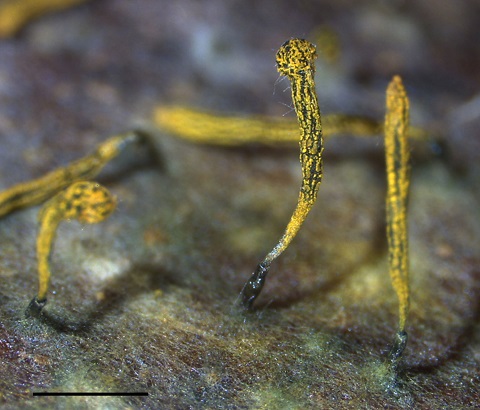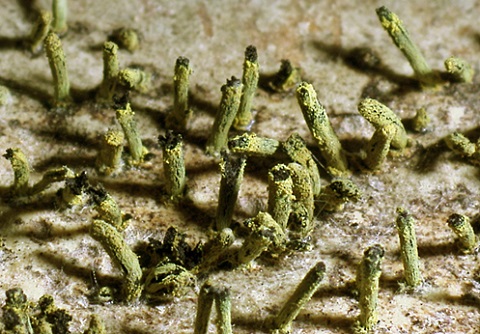Endocalyx species (Cainiaceae) producing unique conidiomata on palm tree debris
The genus Endocalyx was established by Berkeley and Broome (1877), and its species grow mainly on palm tree debris. Endocalyx species reproduce asexually by conidia and hyphae, but the sexual morph is unknown at present. Conidiomata are unique in morphology, synnema/sporodochium-like (Figs. 1, 2), but wholly covered by thin, fragile yellow to brown peridial hyphae. Especially, E. cinctus produces quite unusual synnema-like conidiomata consisting of two parts: (1) a carbonaceous and black basal hyphal cylinder covering a central column; (2) a central synnematous column expanding radially and apically, holding the black conidial mass at the capitulum, and enclosed by yellowish thin peridial hyphae. Surprisingly, these complex conidiomata are easily induced when isolates of E. cinctus are incubated on sterilized palm trees (Fig. 1; Okada and Tubaki 1984, Fig. 30). Conidia of Endocalyx species are aseptate, black to dark brown, and Arthrinium-like in shape (especially in E. melanoxanthus). They mature while pushing upward from the base of the conidiomata, which are still wrapped with thin peridial hyphae, and fill in the whole or upper part of the conidiomata along with colorless filamentous conidiophores.
Okada and Tubaki (1984) reported in detail the morphology, cultural properties, and substrate specificity of E. melanoxanthus collected from some different palms, E. melanoxanthus var. grossus from a Japanese cold-tolerant palm, E. cinctus from a Canary palm, and E. indumentum from an endemic palm in the Ogasawara Islands, using specimens and isolates newly obtained from Japan. At that time, however, several other species described as Endocalyx were not well known, and there were no molecular phylogenetic data on the genus. Recently, two new species of Endocalyx were described by related Thai and Chinese researchers, albeit in a very poorly reviewed state. Delgado et al. (2022) comprehensively reexamined the molecular phylogeny, morphology, cultural properties, and ecology of the representative Endocalyx species using abundant additional materials collected and isolated since 1984, including a newly proposed species from Thailand (E. metroxyli). They revealed that E. melanoxanthus var. grossus, which grows on Trachycarpus fortune (a cold-tolerant palm), should be classified at the species level as E. grossus, and not as a variety, and further clarified the species concepts of the four Endocalyx species listed below. They also confirmed that these representative species of the genus Endocalyx should be classified in Cainiaceae (Xylariales). Unfortunately, no new specimens or isolates were obtained for E. thwaitesii, the type species of the genus.
Endocalyx: Cainiaceae, Xylariales
Endocalyx cinctus Petch
Endocalyx grossus (G. Okada & Tubaki) G. Delgado & G. Okada
(Basionym: Endocalyx melanoxanthus var. grossus G. Okada & Tubaki)
Endocalyx indumentum G. Okada & Tubaki
Endocalyx melanoxanthus (Berk. & Broome) Petch
(= Endocalyx metroxyli Konta & K.D. Hyde)
(See JCM On-line Catalogue of Strains for detailed strain information, https://jcm.brc.riken.jp/en/catalogue_e)
References
Okada G, Tubaki K (1984)
A new species and a new variety of Endocalyx (Deuteromycotina) from Japan. Mycologia 76: 300-313.
https://doi.org/10.1080/00275514.1984.12023839
Delgado G, Miller AN, Hashimoto A, Iida T, Ohkuma M, Okada G (2022)
A phylogenetic assessment of Endocalyx (Cainiaceae, Xylariales) with E. grossus comb. et stat. nov. Mycological Progress 21: 221-242.
https://doi.org/10.1007/s11557-021-01759-9

Fig. 1. Endocalyx cinctus JCM 7946, incubated on autoclaved petiole of Livistona chinensis var. subglobosa, scale = 1 mm.

Fig. 2. Endocalyx melanoxanthus G. Okada Specimen no. 126, on petiole of Livistona chinensis var. subglobosa, kept in a moist chamber for ripening.




